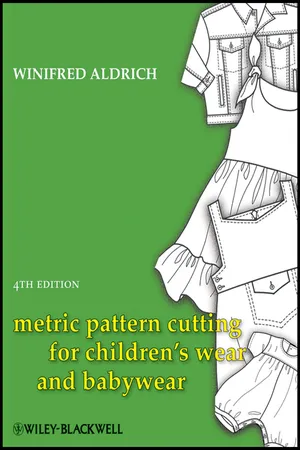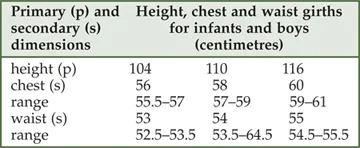
- English
- ePUB (mobile friendly)
- Available on iOS & Android
Metric Pattern Cutting for Children's Wear and Babywear
About this book
This fourth edition of Metric Pattern Cutting for Children's Wear and Babywear remains the standard text book but has three major improvements.
First, the sections have been re-organised to reflect changes in producing and marketing children's clothes. Today's popularity of easy-fitting styles and knitted fabrics means that basic 'flat' pattern cutting is used to construct the majority of children's wear and babywear and this type of cutting is therefore emphasised in this new edition. Shaped blocks and garments, cut to fit the body form, are still included, and are placed in chapters covering some school uniform garments or more expensive fashion or formal clothes. The book now clearly separates the sections useful to student beginners (Parts One, Two and Three), and also offers more advanced or specialist sections for students who wish to pursue a career in children's wear or for designers working in the different manufacturing sectors of the trade.
The second change in this fourth edition is the introduction of colour coding to the sections; this makes it easier to identify specific processes in the book and enhances the illustrations.
Finally, the size charts have been revised to reflect the changes in body sizing. The clear division of the boys' and girls' measurements in the charts has been in response to the way clothes are marketed and to co-ordinate with European size charts. 'Plus' charts for heavier children have also been added.
Frequently asked questions
- Essential is ideal for learners and professionals who enjoy exploring a wide range of subjects. Access the Essential Library with 800,000+ trusted titles and best-sellers across business, personal growth, and the humanities. Includes unlimited reading time and Standard Read Aloud voice.
- Complete: Perfect for advanced learners and researchers needing full, unrestricted access. Unlock 1.4M+ books across hundreds of subjects, including academic and specialized titles. The Complete Plan also includes advanced features like Premium Read Aloud and Research Assistant.
Please note we cannot support devices running on iOS 13 and Android 7 or earlier. Learn more about using the app.
Information
Metric sizing and size charts

Table of contents
- Cover
- Title Page
- Copyright
- Acknowledgements
- Introduction
- Design and pattern cutting for babywear and children's wear
- The growth of children and adolescents
- Tools and equipment for making patterns
- Chapter 1: The basic principles - sizing - using the blocks
- Chapter 2: Specific babywear blocks
- Chapter 3: Specific babywear adaptations
- Chapter 4: The 'flat' blocks - woven and jersey fabrics
- Chapter 5: Basic tops, dresses and skirts for girls
- Chapter 6: Overgarments for girls and boys
- Chapter 7: Sport and leisurewear for girls and boys
- Chapter 8: Nightwear for boys and girls
- Chapter 9: Constructing sleeves
- Chapter 10: Constructing openings, collars and hoods
- Chapter 11: Classic blocks for schoolwear and formal wear
- Chapter 12: Pattern adaptations for schoolwear
- Chapter 13: Pattern adaptations for girls' formal wear
- Chapter 14: The basic blocks and size charts
- Chapter 15: Grading patterns for babywear and children's wear
- Appendix: Aliquot parts
- Glossary
- Supplementary body measurements
- Bibliography and further reading